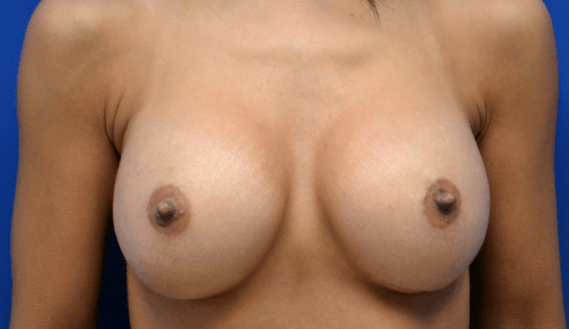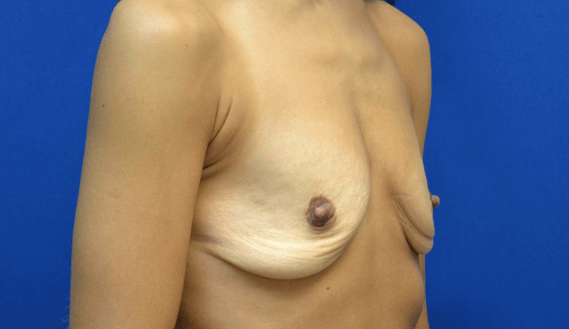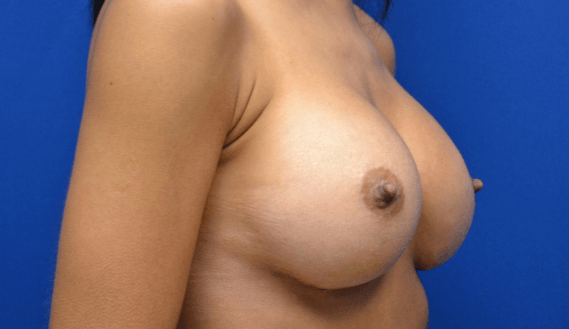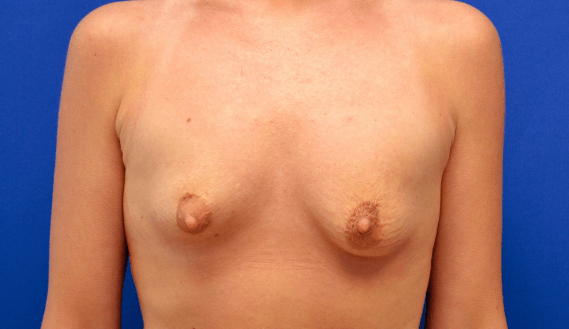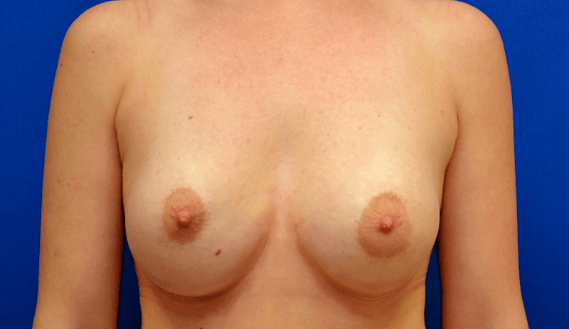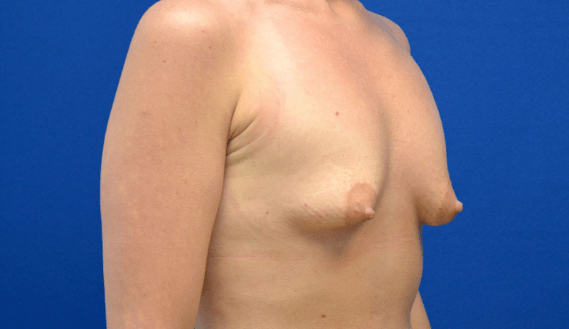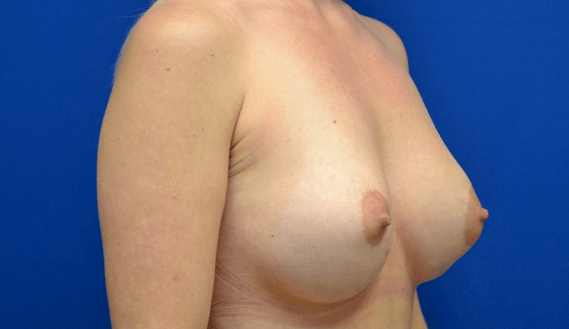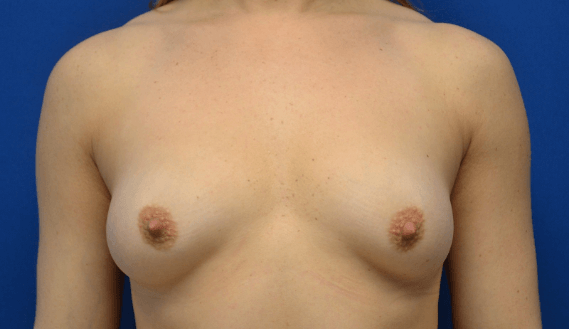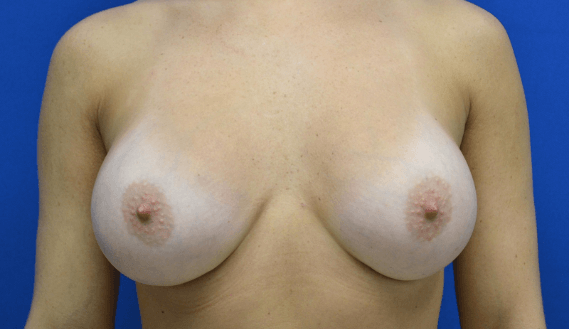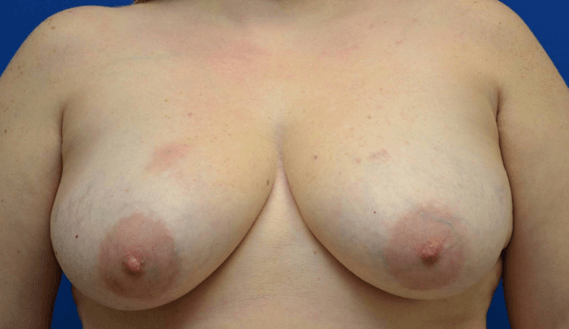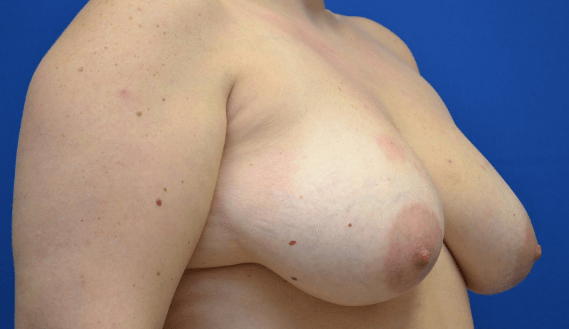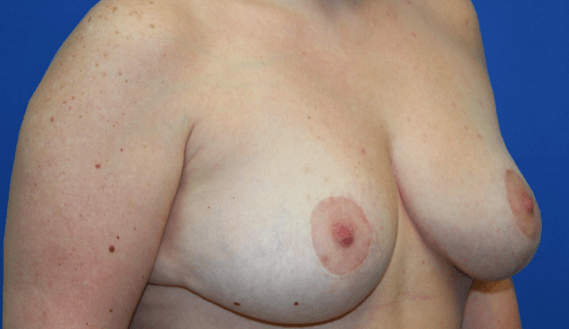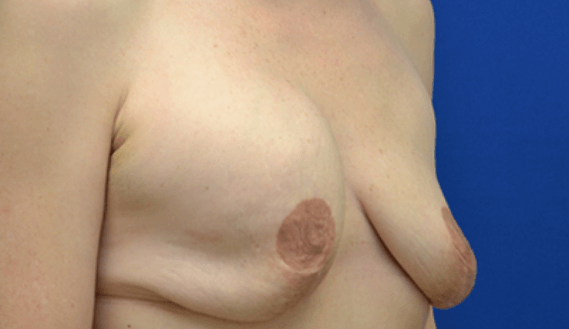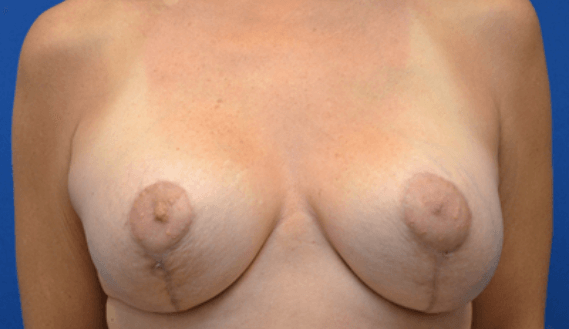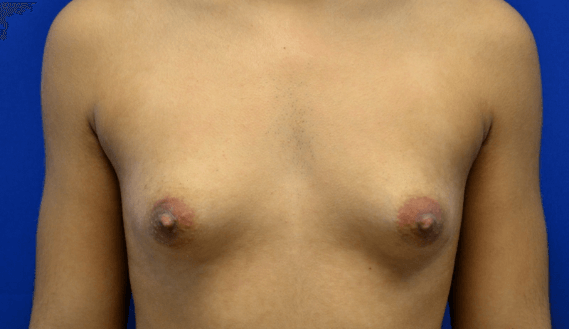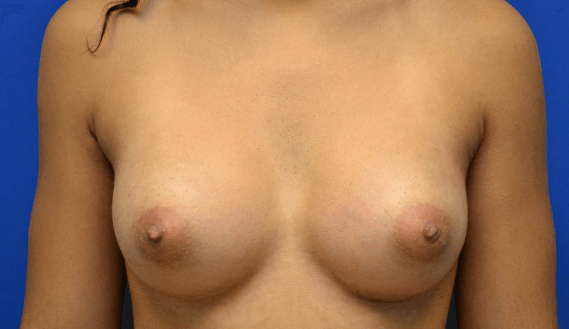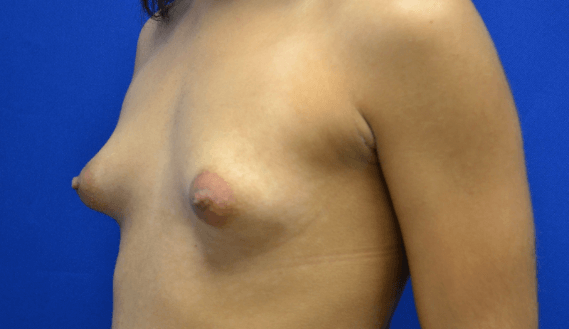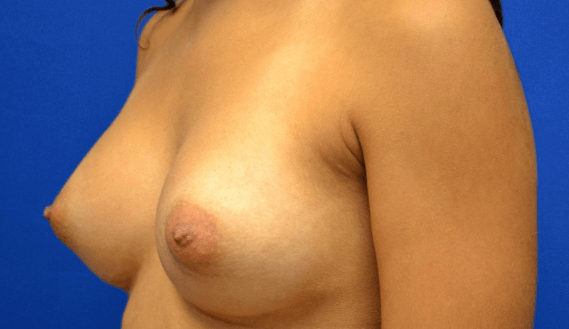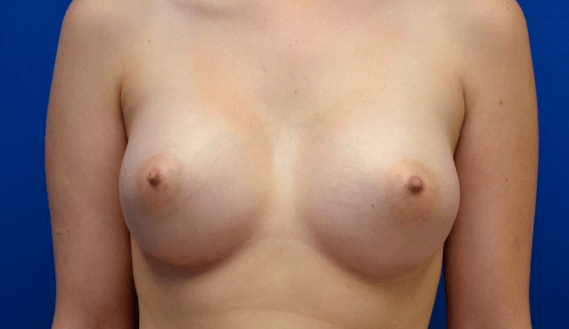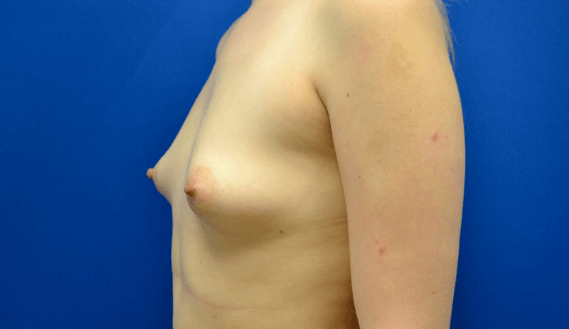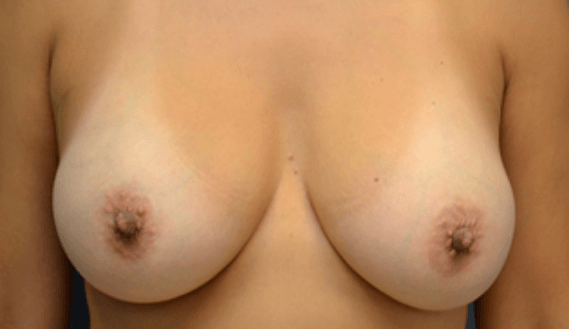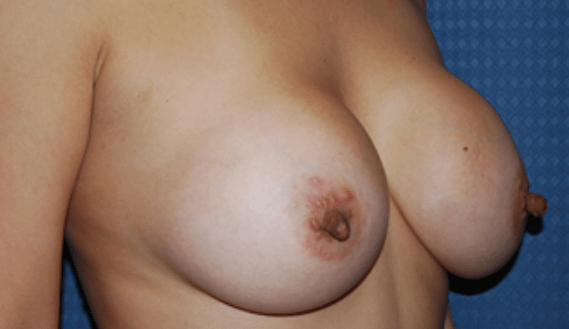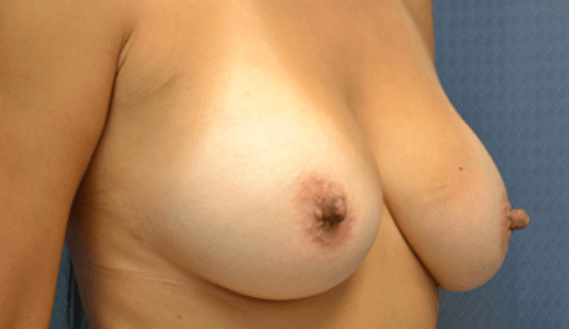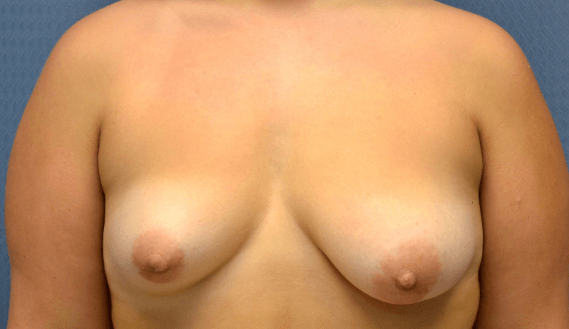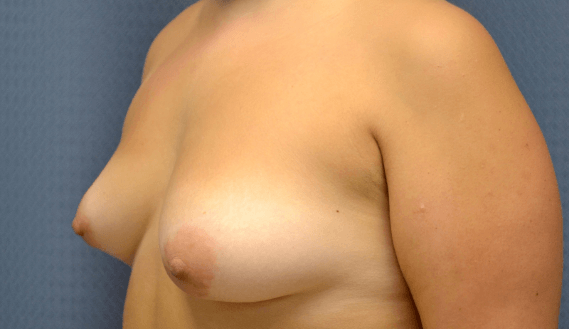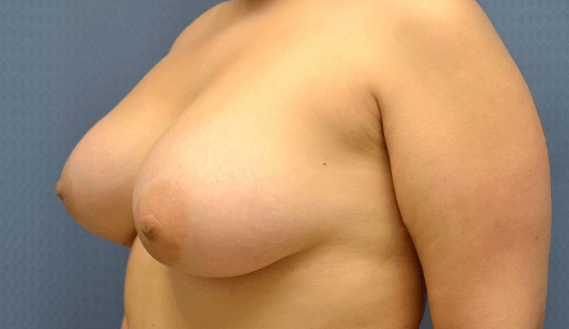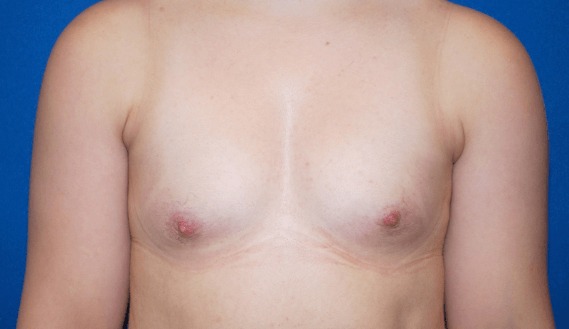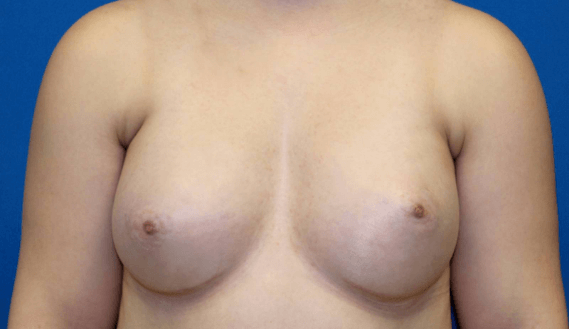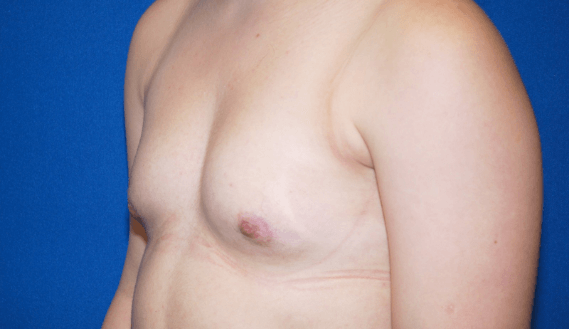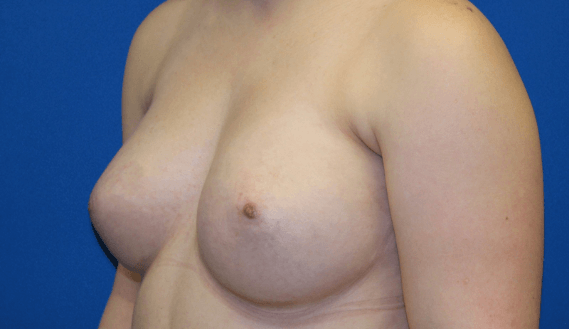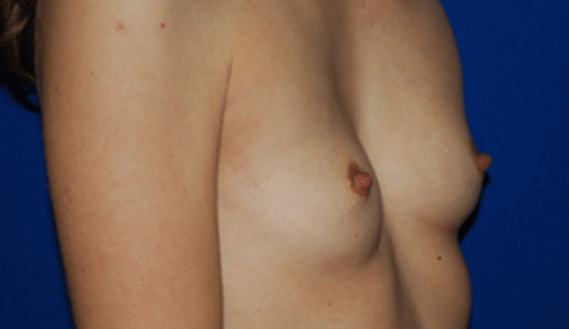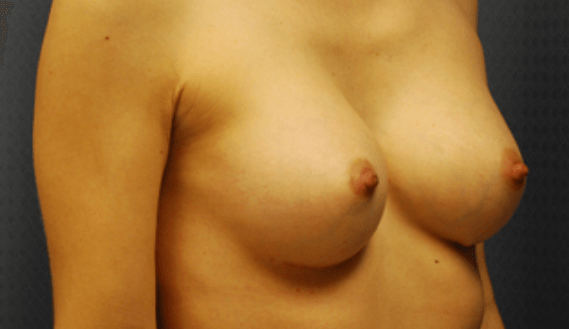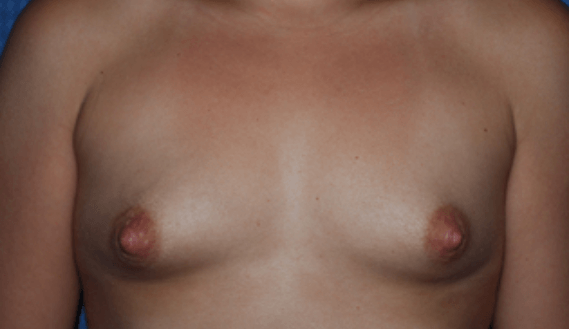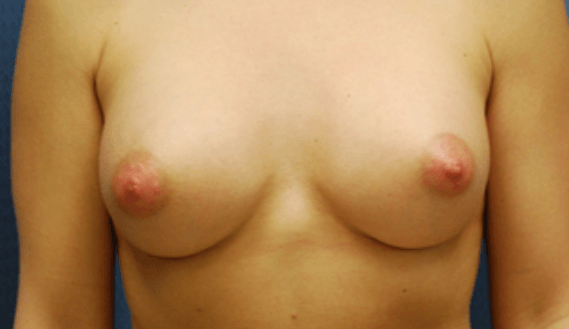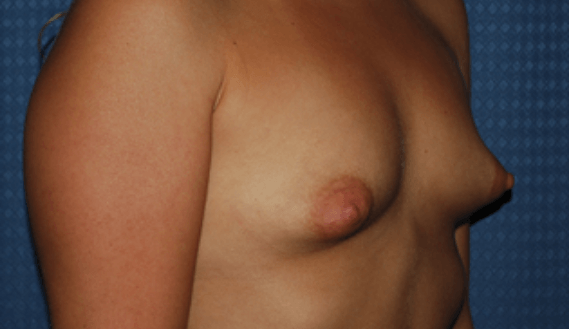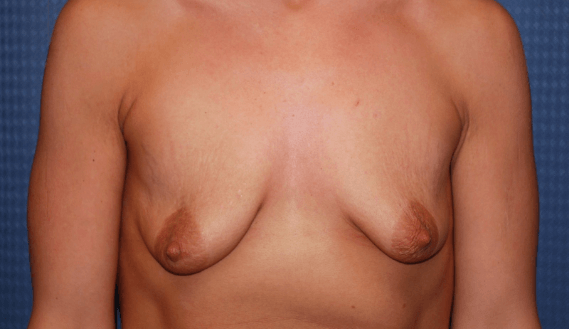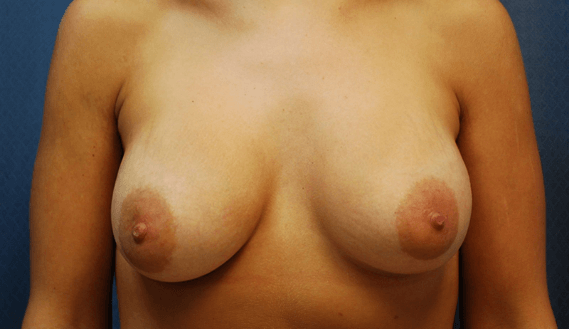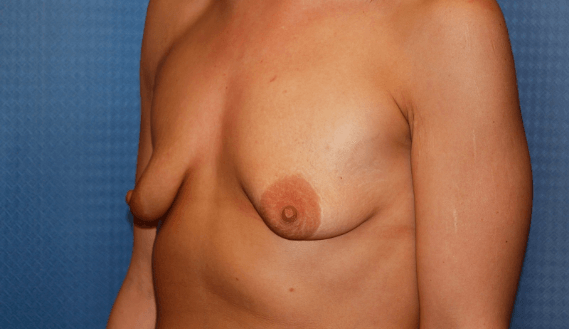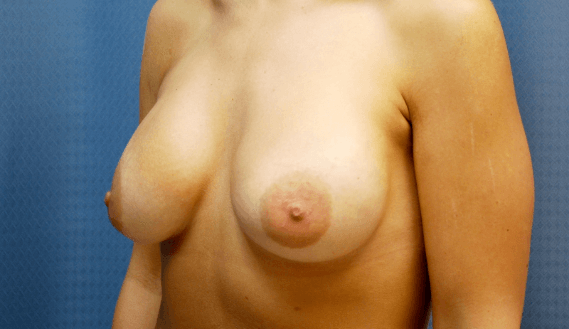Breast Anomalies &
Breast Asymmetry Gallery
Patient 1
Breast Augmentation
This 40-year-old woman is typical of those patients who have lost breast volume as a result of pregnancy. This is often referred to as postpartum involution, quite dramatic in this case. Because her nipples were well above the inframammary fold she would not require a breast lift. However, because of her thinness, Dr. Nini suggested a submuscular, dual plane implant position. This would allow the upper pole of the breast implant to be covered by muscle which would reduce the risk of visible rippling. The lower portion of the implant is covered by breast skin and glandular tissue which allows for a nice expansion of the lower hemisphere. A moderate plus profile 350 cc silicone gel implant was used. Her breast size increased from 32A/B to a D cup. Dr. Nini. (KTN)
Individual results may vary.
Patient 2
Breast Augmentation
This is a 31-year-old woman with severe asymmetric constricted breasts. Her preoperative bra size was a 36A cup. Because of the laxity, or stretchability of her breast skin, Dr. Nini was able to place a larger implant in the dual plane position without the need for preoperative expansion or an adjustable saline implant. However, because of the narrow nature of her chest wall, we used high profile 450 cc silicone implants. She can now wear a C cup bra and is much happier with the size and shape of her breasts. Photos at 6 months. Dr. Nini. (KTN)
Individual results may vary.
Patient 3
Breast Augmentation
This is a 29-year-old woman who desires breast augmentation. She presents with fairly dramatic asymmetry and the insides of both “inframammary folds” are tight and asymmetric. Subglandular breast augmentation with 300 gram high profile implants was performed and the lower portion of the breasts are also more even. Preoperative size was 34A; postoperative bra size is now 34C. Dr. Wey. (PDW)
Individual results may vary.
Patient 4
Breast Asymmetry
This 34-year-old woman desired a breast lift. She explained to Dr. Nini that she was pleased with the size of her breasts but simply wanted an improvement in the shape of her breasts and to reduce the sagging. She was 5 feet 2 inches tall and weighed 150 pounds. Her breasts were a full C cup. A Wise pattern mastopexy, or breasts left, was performed as an outpatient. Her results were photographed one year later. As you can see in the photos, her incisions are beginning to heal nicely. Dr. Nini. (KTN)
Individual results may vary.
Patient 5
Breast Anomaly and Breast Asymmetry
This is a 45-year-old woman who was referred to Dr. Wey after three prior breast implant procedures and mastopexy (breast lift). When she presented, she had distortion and asymmetry resulting from a ruptured left breast implant, grade 4 (severe) capsular contracture of the right breast implant, volume differences and malposition of the nipple areolar complexes. At surgery she had removal of the scar tissue, implant exchange (400 gram high profile on the right and 375 gram high profile on the left) and revision of the breast lift. Preoperative size unknown, postoperative size about 36D. Dr. Wey. (PDW)
Individual results may vary.
Patient 6
Tuberous Breast Correction
This patient is 19 years old, 5 feet 5 inches tall, weighing 154 pounds. She wears a size 36A cup and desires to be a small to medium D cup. Her preoperative photographs demonstrate an asymmetric, moderately severe tuberous breast condition. In this patient, Dr. Nini decided to use an adjustable saline breast implant as a tissue expander. It was placed in the dual plane pocket and utilized a small injection port buried just under the skin and covered by the bra strap. It is just barely visible as a small bump on the breast side view. Into this port, we are able to inject saline solution to fill the implant and gradually expand the breast. The technique of tissue expansion for the correction of tuberous breasts is widely accepted. What is unique about this approach, is that we use a saline implant which eliminates the need for a second operation. This patient can simply choose to have the fill port removed and keep the saline implant as her final device. On the other hand, she could have the saline devices removed and exchanged for a silicone breast implant. There is a lot of flexibility with this approach. Dr. Nini. (KTN)
Individual results may vary.
Patient 7
Constricted Breast Correction
This patient is a 23-year-old woman who desired silicone breast augmentation. She has an asymmetric constricted breast condition. Her right breast is higher and demonstrates less lower pole fullness. Her preoperative bra size was 36A. To address this condition, Dr. Nini used a dual plane partial submuscular augmentation technique. She is now a full C cup following the placement of 350 cc smooth round moderate plus profile silicone breast implants. Her photos are taken one year after surgery. Dr. Nini. (KTN)
Individual results may vary.
Patient 8
Capsular Contracture
This patient is a 38-year-old woman who had undergone a subglandular augmentation with a smooth round silicone breast implant 350 cc in 2009. She had experienced capsular contracture in downward descent of the breasts and was disappointed with the results. She also felt that her breasts were a bit too large for her.A revision was carried out by Dr. Nini, performing capsulectomy and replacing the 350 cc implant with a 275 cc silicone implant. In addition, Strattice, an acellular dermal matrix, was used as an internal sling to support the breast implants in a new elevated position. There is also some evidence that ADMs will reduce the incidence of capsular contracture. Her postoperative photographs were taken six months later and her breast aesthetics were greatly improved. Dr. Nini. (KTN)
Individual results may vary.
Patient 9
Breast Asymmetry
This patient is a 20-year-old woman with developmental breast asymmetry. Her preoperative photographs demonstrate an asymmetric constricted breast deformity. Note the smaller right nipple areolar complex and the shortened distance between the right nipple and chest wall. On the left side, I placed a fixed volume 280 cc saline implant in the subglandular position to better elevate the nipple areolar complex without additional surgical scars. On the right side, I used an adjustable saline implant in the submuscular dual plane position to help expand the lower hemisphere of the breast. A micro-fill port was placed beneath the skin to allow for post operative filling of the right implant. In order to achieve her goal of a full C cup, small D cup, the final fill volumes were 500 cc on the right and 280 cc on the left. The fill port was removed in the office under local anesthesia. Adjustable saline implants are often a good choice when expansion of the lower hemisphere soft tissue envelope is necessary, such as the case in this patient’s right breast. Dr. Nini. (KTN)
Individual results may vary.
Patient 10
Breast Asymmetry
This 19 year old woman presented with a failure of breast development. Her photographs demonstrate an asymmetric nipple position and virtually no space between the nipple and the fold beneath the breast. As you can imagine, there is very little room for a breast implant. Because of the need for lower hemisphere dimension, Dr. Nini chose a saline breast implant, noting that the weight of the saline implant combined with the hydrostatic forces is more likely to expand the lower soft tissue envelope than a silicone device would. Following intraoperative tissue expansion combined with a dual plane approach, a total fill volume of 350 cc was achieved. Her photographs were taken 6 months after the procedure. Dr. Nini. (KTN)
Individual results may vary.
Patient 11
Pectus Excavatum
This is a 35-year-old woman who requested a breast augmentation. She was a 34A cup and desired a C cup. Her examination was interesting because she presented with a pectus excavatum, a wider left hemi-chest wall, an elevated left shoulder and a left breast, nipple and fold that were slightly higher than the right. In addition, the left breast was approximately 100 g larger than the right.A pectus excavatum is sometimes described as a “sunken breastbone”. In this situation, Dr. Nini prefers a sub-muscular approach which tends to keep the implants from collapsing into the midline. In this patient who is 5 feet 4 inches tall and weighs 112 pounds, we used a 225 cc smooth round silicone classic profile implant on the left side and a 325 cc smooth round high profile implant on the right. Different profiles were used to balance the chest wall asymmetry in an effort to create symmetric projection. Her results can be seen 5 months postoperatively. Dr. Nini. (KTN)
Individual results may vary.
Patient 12
Tuberous Breast Deformity Correction
This is a 30-year-old woman seeking breast augmentation. She explained that she had nursed one child and after this pregnancy had lost volume in the upper poles of the breast. She wanted to be a small C cup. She was 5 feet 2 inches tall and weighed 117 pounds. However, examination of the breasts revealed high and tight inframammary folds with nipple asymmetry and a very short distance between the nipple and the inframammary fold. This is a characteristic of the constricted breast or tuberous breast deformity. This is a difficult type of augmentation and if not performed correctly the breast implants can end up very high on the chest wall. For this patient a 300 cc smooth round implant was chosen and the dual plain surgical approach was recommended by Dr. Nini. This is a partial sub muscular procedure that promotes lower hemisphere expansion which is what she needed. Although she still has a mild asymmetry, we were very pleased with her outcome. Her photographs are taken 5 months postoperatively and she is a small C cup. Dr. Nini. (KTN)
Individual results may vary.
Patient 13
Breast Asymmetry
This is a 22-year-old woman who had lost 100 pounds by dieting and exercise. As a result, she had experienced tremendous loss of breast volume. As you can see from her preoperative photographs, a considerable asymmetry existed between the left and right sides and the base diameters were too narrow for her chest. Ideally, the outer breast shape should not allow the chest or ribs to show; this helps balance the upper body with the hips. Most surgeons would have insisted on a breast lift, however, she absolutely did not want any visible scars.My plan for her was to choose an implant volume, profile and placement that would correct some of the sagging, asymmetry and chest wall show. A 350 cc moderate plus silicone gel implant was placed in the sub-glandular position with a very nice result. Although it’s not perfect…this patient demonstrates how we are able to meet the patient’s goals by “thinking outside of the box sometimes”. Her photos were taken 10 months after her surgery. Dr. Nini. (KTN)
Individual results may vary.
Imagine Yourself at PSANJ Today!

